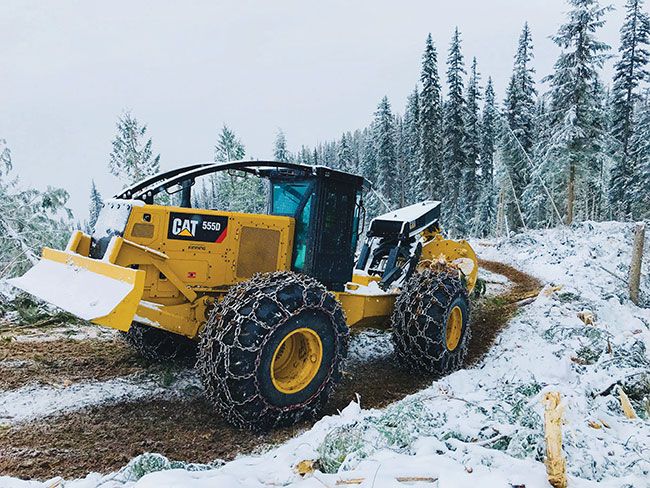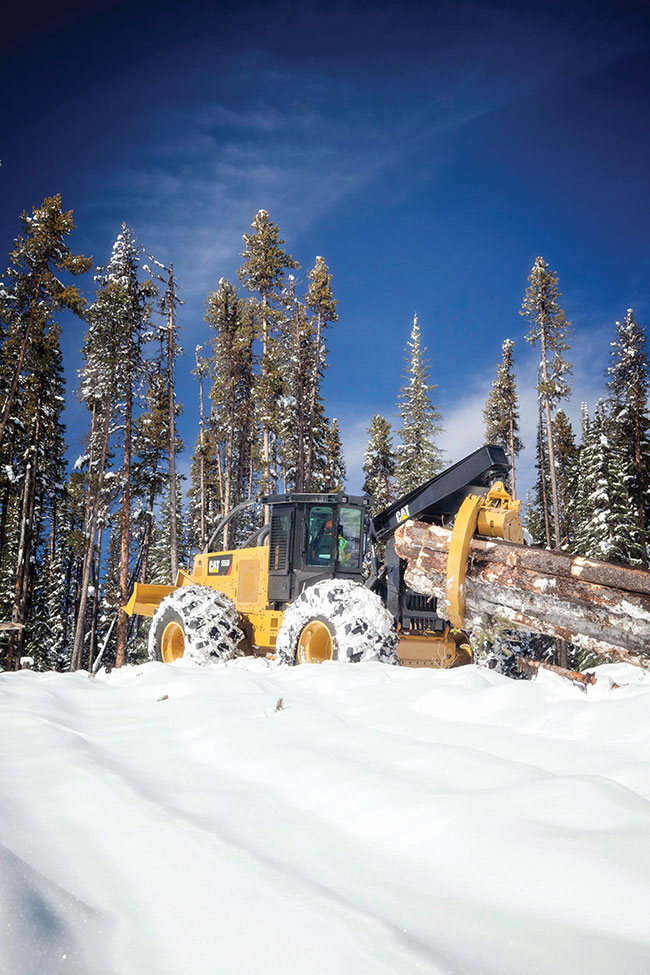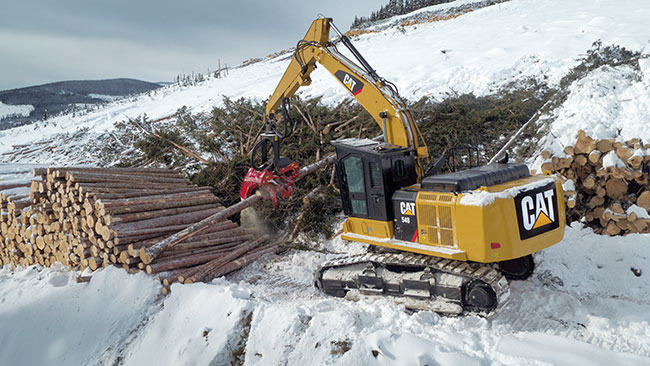
Features
Harvesting
Maintenance
Gear Zone: 5 tips for winterizing your logging fleet
Healthy equipment maintenance means sticking to your plan
December 2, 2019 By David Beleznay
 Photo courtesy Finning Canada.
Photo courtesy Finning Canada. Keeping forestry equipment productive and on track can be a tough job even in the best conditions. Add in changing weather, colder temperatures and harsh conditions, and your equipment is at risk of breakdowns and high repair costs. The longer a machine is out of use or idle, the greater the impact on jobs from a timing and cost perspective. Properly winterizing your machine at the start of the season and performing routine upkeep can prevent winter conditions becoming frustrating and costly for you and your crew.
To ensure your forestry equipment continues performing at its best, owners need to think about winterizing their fleet as soon as temperatures start dropping. Maintaining your equipment throughout the winter months is key. The right maintenance schedule will keep your machine healthy, your operators safe and your engine in top condition.
Here are five tips on how you can get better performance and life out of your forestry equipment during the winter.
Tip 1: Check your tires
If you use tire-mounted equipment be sure to check both wear and air pressure before winter sets in and during the winter season. Air pressure is impacted in both oxygen and nitrogen filled tires when the temperature changes. Cold weather causes tires to lose air pressure, so perform an extra check on your coldest days as tires that are inflated below the recommended pressure will have a shortened life. Using dry nitrogen can help eliminate ice crystals that could potentially hold the valve stem open in the tire.
Make sure you look for cracks, remove debris and dirt and keep an eye out for even wear on tires. If part of the tire looks worn out, it may be time to replace it.
When operating in the winter months, there are several things operators can do to help properly maintain healthy tires and equipment, particularly in heavy snow. This can include minimizing high operating speeds and on-road travel during the winter.

Visual inspections can often identify problems before they become an issue and incur costs. Photo courtesy Finning Canada.
Tip 2: Pay close attention to your engine, fluids and hydraulic systems
The first step for winter maintenance is to consult the operator’s manual for guidelines regarding engine oil, coolant and fuel. Cold weather operation tends to accentuate any fuel quality issues, such as moisture or contaminants, so ensure you are using the right fuel for cold weather and follow the schedule from your dealer for fuel changes.
Warming up your machine prior to use can reduce the risk of shock to components caused by cold fluids or hydraulic systems. Don’t rush this process – running a machine too quickly that has been shut down in extreme cold temperatures can lead to severe engine damage. Equipment is more brittle in the cold and hydraulic lines can easily get blocked, which can result in leaks and failures. Providing your machine with sufficient warm-up will allow both the hot and cold engine parts to fully expand, meaning better operation overall.
Next-generation forestry machines are starting to include a built-in system that will check for low fluid levels in the engine oil, hydraulic oil and engine coolant and warn the operator through the monitor. Machines today are also often equipped with a buzzer that can warn operators of critical events such as engine pressure decrease, high coolant temperatures or high hydraulic oil temperatures. Be sure to listen for alerts and take immediate action.
When it comes to your hydraulic system, test it to ensure that it reaches its ideal operating temperature. You can also protect against mechanical and corrosive wear by using the right hydraulic oil with a high zinc content, which reduces wear and extends pump life. Regular fluid analysis can help you schedule service for your machinery at optimum times based on fluid use.

Warming up your machine prior to use can reduce the risk of shock to components caused by cold fluids or hydraulic systems. Don’t rush this process. Photo courtesy Finning Canada.
Tip 3: Store diesel exhaust fluid (DEF) and starting fluid properly
DEF freezes at prolonged exposure to temperatures of -11 C or lower, so make sure the area where you store it is well insulated. If your diesel engine is equipped with ether starting aid, ensure the fluid is stored at room temperature and inject only when the engine is cranking. When you start an engine in temperatures below -18 C, it is important to use a new container of ether to ensure there is adequate delivery process. Although DEF is still useable after freezing and thawing, starting fluid is flammable and, for safety, such products should be stored in an appropriate container to avoid bursting and kept separate from the operator’s compartment.
Tip 4: Conduct a walk-around before and after you use your machine
Visual inspections can often identify problems before they become an issue and incur costs. Pre- and post-operation inspections are an important part of your daily maintenance. Operators should look for things like mud, snow or dirt that could infringe on the operation of the machine. Also keep an eye out for any cracks, cuts and worn spots on hydraulic hoses. Address these issues immediately and remember to refer to your operator’s manual if making any adjustments.
Before starting the machine, you should also check the air cleaner for any openings that could draw in unfiltered air. Some machines now feature a radial seal air filter with a double-layer filter core for more efficient filtration.
Cold temperatures can also cause issues with electrical wiring and connections. Proper inspections can identify any fraying or damaged insulation that may need immediate attention.
Tip 5: Stick to a maintenance schedule and use remote fleet monitoring programs
Regularly scheduled maintenance can help extend a machine’s service life, identify issues, prevent unnecessary costs, reduce idling and downtime and increase fuel efficiency.
Many companies now offer remote-monitoring programs for your equipment. This can help you keep on top of maintenance and provide a unified view of the health, location and productivity of your entire fleet, as well as expert recommendations on equipment maintenance and repairs. The data can provide asset information and fluid analysis and inspection results. These platforms can also be customized to help meet your own unique business needs.
The right equipment dealer should be able to provide you with the best service to ensure your forestry equipment stays healthy all season long. Look for a partner who values innovation and understands your business and the key performance requirements that will help save you time and money in the long run.
David Beleznay is the forestry corporate account manager for Finning Canada.
Print this page